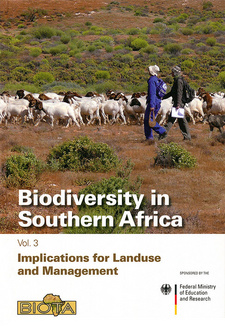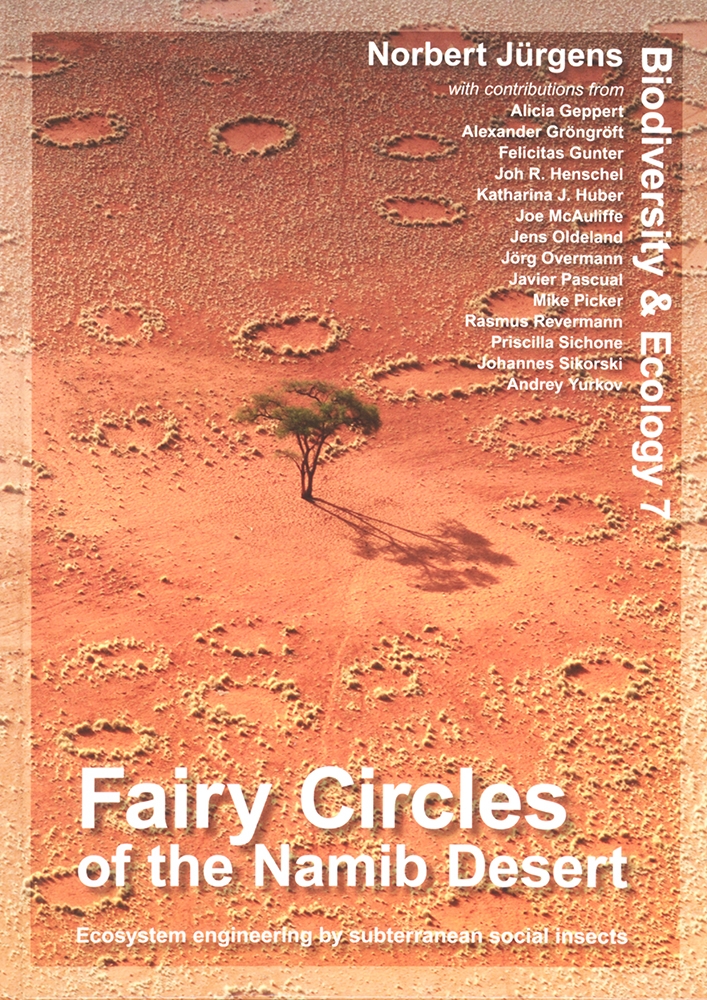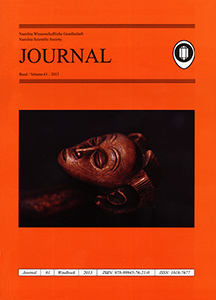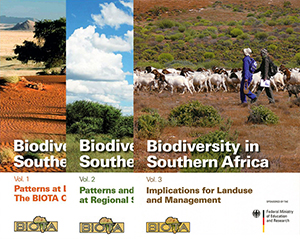Biodiversity in southern Africa, Volume 3: Implications for landuse and management

Biodiversity in southern Africa, Volume 3: Implications for landuse and management. BIOTA AFRICA. ISBN 9783933117472 / ISBN 978-3-933117-47-2 (Europe) / ISBN 9789991657332 / ISBN 978-99916-57-33-2 (Southern Africa)
This volume 3 of Biodiversity in southern Africa, Volume 3: Implications for landuse and management, is of interest for all decision makers regarding landuse and for resource managers, irrespective of the geographical scale, at which they operate.
Here, we use an approach, which acknowledges the similarity of ecosystems and organismic compositions within each of the major biomes along the transect (i.e. Woodland Savanna, Thornbush Savanna, Nama Karoo, Succulent Karoo, and Fynbos). This approach allows for general statements to be made regarding the implications of our research results for landuse and management of biodiversity within the biome. Therefore, each of the five biome Chapters forms a summary of all the results with a focus on the implications of these findings for management. At the end of this Volume, Part V contains three useful indices, i.e. one that explains the abbreviations used throughout the book, one with all scientific names occurring in the book, and one with biosketches and contact data of all authors. Finally, an Electronic Appendix (CD at the back cover of Volume 3) provides original data, complete species lists, and further additional information. A symbol and the reference in the text (Electronic Appendix) indicate, for which aspect additional information or data can be found on the CD. The information on the CD is structured according to the sequence of the Chapters and Subchapters.
Contributing authors to Biodiversity in southern Africa, Volume 3: Implications for landuse and management
Table of content: Biodiversity in southern Africa, Volume 3: Implications for landuse and management
Part IV Implications for landuse and management
IV.1 Causes and perspectives of land-cover change through expanding cultivation in Kavango
IV.1.1 Introduction
IV.1.2 Research site, setting, and methodologies
IV.1.3 The status quo of the cultivation system
IV.1.4 The dynamics of expanding cultivation
IV.1.5 Biodiversity status quo and potentials
IV.1.6 Human aspects of cultivation within the farming system
IV.1.7 The role of statutory and customary law in governing the cultivation of land
IV.1.8 Summarising results
IV.1.9 Discussion and steps forward
IV.2 Impacts of landuse and climate change on the dynamics and biodiversity in the Thornbush Savanna Biome
IV.2.1 Introduction: current knowledge and key challenges
IV.2.2 "When is a Change a Change?"
IV.2.3 Eco-hydrology of Thornbush Savanna
IV.2.4 Vegetation pattern and biodiversity dynamics
IV.2.5 Risk assessments
IV.2.6 Integrated socio-economic and ecological research
IV.2.7 Recommendation for landusers and conservation planners
IV.2.8 Future research needs
IV.3 An ecological-economic analysis of the pastoral systems of the Nama Karoo in southern Namibia
IV.3.1 Introduction
IV.3.2 Rehoboth area: dynamics of small-scale commercial pastoral systems
IV.3.3 Keetmanshoop region: socio-economic analysis of large commercial ranching systems of south-central Namibia
IV.3.4 Namaland: drivers of landuse in communal pastoralism
IV.3.5 Rangeland - landuse interactions and suggestions for the management of pastoral systems in the Namibian Nama Karoo
IV.4 Environmental and socio-economic patterns and processes in the Succulent Karoo - frame conditions for the management of this biodiversity hotspot
IV.4.1 Introduction
IV.4.2 Interdependence of soils and vascular plant vegetation in the Succulent Karoo
IV.4.3 Old field succession in the Namaqua National Park, Succulent Karoo, South Africa
IV.4.4 Restoring degraded rangelands in the Succulent Karoo: lessons learnt from four trials
IV.4.5 Land management in the biodiversity hotspot of the Succulent Karoo. A case study from Soebatsfontein, South Africa
IV.4.6 Conclusions and further research needs
IV.5 Keeping the Cape Lowland archipelago afloat
IV.5.1 Introduction
IV.5.2 Diversity disrupted
IV.5.3 Processes disrupted
IV.5.4 How to deal with fragmentation and its effects - management and intervention
Part V Indices
V.1 Abbreviations
V.2 List of scientific names
V.3 Biosketches of authors and editors
This is an excerpt from Biodiversity in southern Africa, Volume 3: Implications for landuse and management.
Title: Biodiversity in southern Africa, Volume 3
Subtitle: Implications for landuse and management
Editors: Norbert Jürgens; Ute Schmiedel; M. Timm Hoffman
Contributers: as listed above
© University of Hamburg
Publisher: Klaus Hess Publishers
Göttingen, Namibia 2010
ISBN 9783933117472 / ISBN 978-3-933117-47-2 (Europe)
ISBN 9789991657332 / ISBN 978-99916-57-33-2 (Southern Africa)
Hardcover, 21 x 30 cm, 350 pages, throughout, throughout photos, figures, tables and maps, CD
Jürgens, Norbert und Schmiedel, Ute und Hoffman, M. Timm und Haarmeyer, Daniela H. und Luther-Mosebach, Jona und Dengler, Jürgen und Finckh, Manfred im Namibiana-Buchangebot
Fairy Circles of the Namib Desert: Ecosystem engineering by subterranean social insects
Fairy Circles of the Namib Desert: Ecosystem engineering by subterranean social insects. Biodiversity & Ecology, Volume 7
Journal 61-2013 (Namibia Wissenschaftliche Gesellschaft / Namibia Scientific Society)
Dies ist Band 61 des Journals der Namibia Wissenschaftliche Gesellschaft (Namibia Scientific Society), der 2013 herausgegeben wurde. Die Hauptbeiträge dieser Ausgabe sind in deutscher Sprache gehalten.
Biodiversity in southern Africa
Biodiversity in southern Africa introduces to results of 10 years of joint research by South African, Namibian, and German institutions within the project “BIOTA Southern Africa.



